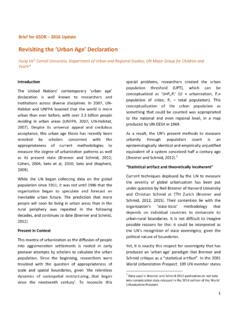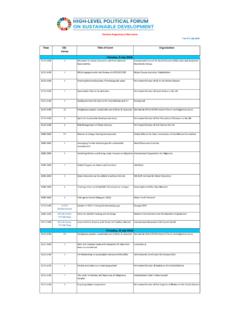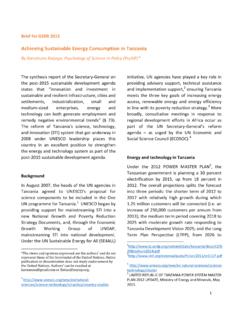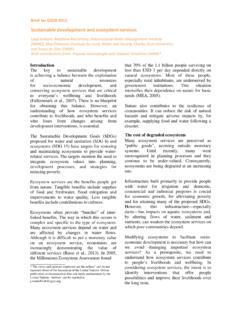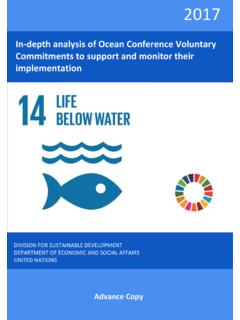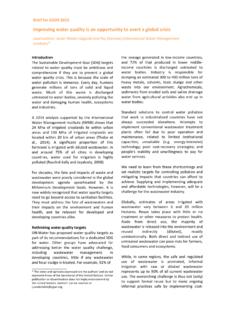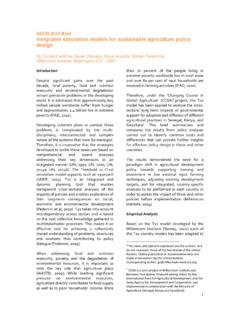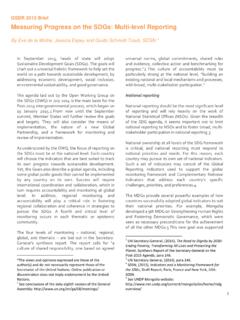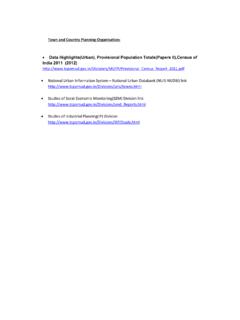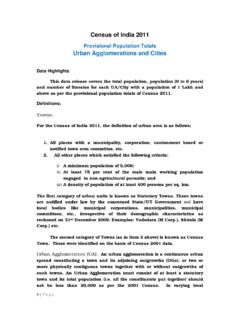Transcription of 108 Singh and Grover Sustainable Urban …
1 1 *The views expressed in this brief are the authors and not those of the United Nations. Online publication or dissemination does not imply endorsement by the United Nations. Brief for GSDR 2015 Sustainable Urban environment in delhi Mega City: Emerging Problems and Prospects for Innovative Solutions Singh , Department of Geography, delhi School of Economics, University of delhi Aakriti Grover , Department of Geography, Swami Shraddhanand College, University of delhi * Introduction Cities are the engines of growth and indicators of progress. Besides, they have widespread implications on environment and human society. There is large scale incidence of Urban poverty and slums in cities of developing countries. This has resulted in mismatch between infrastructure, resources and population , leading to degraded and unsustainable Urban environments.
2 The unprecedented Urban growth is also referred as pseudo-urbanization for the reason that this growth is exceptionally unbalanced. The footprints of urbanization, concretization and land use conversion are visible in the form of Urban heat island (UHI) formation that poses threat to human health and wellbeing. The study addresses above issues in national capital - delhi . population Increase and Urban Growth: Vice or Virtue The total population in delhi has witnessed steep rise from million in 1951, which was of total population of India, to million in 2011(Directorate of Census Operations, 2011). The density of population was 4,194 in 1981 and rose to 11,297 in 2011(Directorate of Census Operations, 2011). The Urban population was in 1951 and in 2011.
3 The number of villages reduced from 300 in 1961 to 165 in 2001. Area wise, the rural areas have shrunk from km2 in 1991 to km2 in 2001. In 1991 rural- Urban share was , which in 2011 became Two of the nine districts, , Central and New delhi are presently 100% Urban . Large scale migration from the neighboring states of Uttar Pradesh (46%), Bihar (13%) and Haryana (10%) is observed. Nearly 44% of the total population resided with 4-5 members per household and in 6-8 persons per household (2011). The of total rural population and of the Urban population is below poverty line (Directorate of Economics and Statistics, 2012). Land Use and Environmental Changes Forest: The Breathers The vegetation cover is imperative for balanced atmospheric temperature and sustenance of life.
4 As per the reports of Forests Survey of India (2011), total area of forest and tree cover was 40 and 111 km2 respectively in 2001 that increased to 120 and km2 in 2011 (Forest Survey of India, 2011). total vegetative cover doubled in a decade from 10% to on account of substantial increase in tree cover under the Green Action Plan of delhi Government. Open forests have coverage share of km2 and dense forests are merely 6 km2 (Forest Survey of India, 2011). The central and south eastern region is greener than western half of the city. Water Bodies: Elixir of life Water bodies are crucial for Sustainable Urban eco-hydrology. total area under water bodies has considerably declined from km2 (1970) to km2 (2008), mainly lost to Urban 2 growth ( Singh ; Gahlot & Singh , 2013a).
5 In addition, the groundwater level declines for 2m every year. Diminishing water bodies has deep impact on environmental health ( Singh ; Gahlot & Singh , 2013b). Pollution load in the river Yamuna added from various sources like industries and domestic and long dry season, has virtually converted it into a nala. Najafgarh drain along with its 70 sub-drains is the biggest polluter of the river. The BOD load increased times (1980-2005) with total of 276 tonnes per day (Central Pollution Control Board, 2006). Air Quality: Menace to Human Health The air pollution levels in delhi are strikingly high and the transport sector is major contributor. Nearly tonnes of CO, tonnes NOx, tonnes HC and tonnes particulate matter is released in delhi s atmosphere per day (Department of environment and Forests, 2010).
6 The CO has dipped drastically post-CNG use ( 1999); SPM and RSPM have increased, SO2 has declined marginally and NO2 is still high over 1997-2011(Department of Planning, 2013). The composition of pollutants have changed with the introduction of CNG, new pollution standards and phasing out of old vehicles. The concentration of CO, SO2 and PAHs has declined, while NOx and SPM increased (Chelani & Devotta, 2007; Ravindra, Wauters, Tyagi, Mor, & Grieken, 2006; Sindhwani, & Goyal, 2014). The rise in NOx is attributed to CNG use and SPM to the diesel vehicles growth. Vehicular Growth: Regulate, Restrict, Restrain The vehicles in delhi have doubled from 1999-2000 to 2011-12 (Chelani & Devotta, 2007). The highest growth rate is for taxis, whereas private cars and jeeps experienced an increase of Over 90% vehicular population of the city comprise of private vehicles (cars, jeeps, motor cycles and scooters) (Chelani & Devotta, 2007).
7 In 1980-81, the total road length was 14,316 kms that doubled to 28,508 kms in 2000-01 and increased to 32,663 kms by 2011. Urban Built-up Land: Moving Towards Global City The Urban land use has increased tremendously with km2 till 2003 and further km2 added from 2003 to 2011 at the cost of fallow land, agricultural area; shallow water bodies and scrub land (Sharma & Joshi, 2013; Mohan, Pathan, Narendrareddy, Kandya & Pandey, 2011). The built up area increased by about 17% from 1997 to 2008. UHI: Localized Global Warming The land surface temperature (LST) is a critical indicator of UHI assessment. UHI is a phenomenon, whereby city experiences elevated temperature in comparison to the surrounding hinterland due to trapping of insolation by atmospheric gases, high rise buildings and concrete surfaces of asphalt, metal, tiles and bricks.
8 It causes heat waves in summers and leads to heat stress and mortality. It changes the micro climate, hence, changes in transmission and life cycle of many diseases (McGeehin & Mirabelli, 2001). The satellite data is widely used for understanding Urban micro-climatology and UHI ( Singh & Grover , 2014). The LST, in October, range between 23 to 46 C with lowest value for water bodies and highest for fallow land (Mallick, Kant & Bharath, 2008) and UHI was intense in dense commercial areas (Mohan, Kikegawa, Gurjar, Bhati & Kolli, 2013). There are seasonal and diurnal variations in LST and UHI ( Singh , Grover & Zhan, 2014). It is less intense on summer owing to aerosol distribution and 3 presence of river Yamuna (Pandey, Kumar, Prakash, Kumar & Jain, 2009). However, the UHI formation is weak in delhi due to healthy tree-cover and low rise building ( Singh & Grover , 2015).
9 The higher temperatures are associated with fallow agricultural land, industrial and concrete surfaces. There is formation of Urban heat belts corresponding to high density areas across the city. Increased LST coupled with atmospheric pollutants is menace to human health. Human Health at Stake The modifications in atmospheric composition, surface geometry and characteristics, UHI creation, increased pollution, land use alterations have global impacts as the scale of urbanization is widespread in the developing countries. The changing city environment has implications on ecology, human morbidity and mortality. In all, there are 815 medical institutions having a meager capacity of 42,598 beds. In a span of past 7 years, till 2011, only 4 hospitals, 1 PHC, and 2 medical colleges have been added to the existing infrastructure.
10 The growth of dispensaries (246), maternity, nursing homes (120) and sub-centres (50) is much The health infrastructure is sparse in proportion to demand. Mortality from respiratory infection is 43%, of which 16% are infant deaths (Department of Planning, 2011). Most vulnerable groups are below 5 and 55+ age groups. Over 30% of the children suffer from respiratory problems (Siddique, Banerjee, Ranjan Ray & Lahiri, 2010). In 2006, 161 deaths from respiratory cancer took place that increased to 420 in 2012. Nearly 40,000 Indians experience early death due to air pollution every year where 7,500 are from delhi (Brandon & Homman, 1995; Ravindra, Wauters, Tyagi, Mor & Grieken, 2006). Solutions: Quest for Innovation There is wide array of problems faced by Urban centers.
